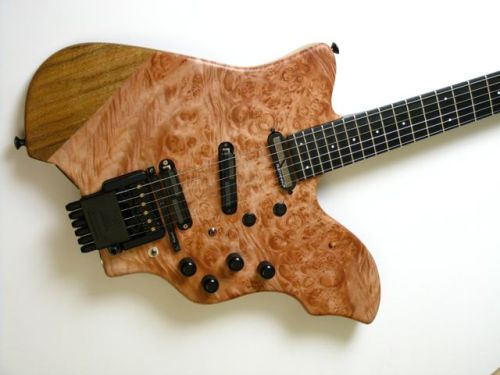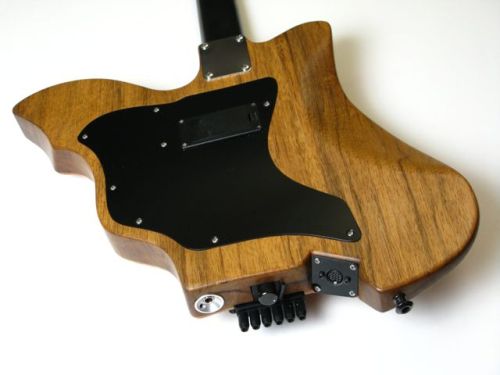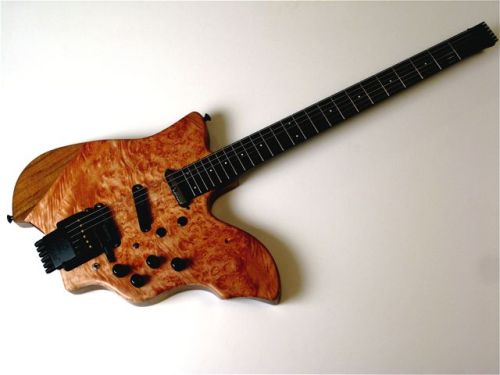Headless Baritone – Andrews Guitars
Vance Galloway appreciates innovative stringed instruments. In fact, he’s had builder Aaron Andrews of Andrews Guitars make him three instruments “designed to be more ergonomic than standard guitars and basses and focused on playability while sitting”. The most recent of the three is a Limba bodied headless baritone guitar.
Making the Guitar Body
Made of black limba with a beautiful quilted maple top, Vance describes the body as “somewhere between a Klein guitar on top and a ‘sitting friendly’ design that Aaron and I came up with for our first guitar which worked out VERY VERY well – better than the Klein I used to have, IMHO.”


Key to the instrument’s seated position is its placement on the left leg instead of the standard right leg position. Vance thinks “the angle of the instrument is absolutely divine while seated this way.”
Its builder describes how he came up with the shape:
Basically, Vance wanted the instrument to fit him the way he prefers to sit and the way he stands. I took tape measure cardboard and duct tape as well as life size cut-outs of a Klein and had Vance sit down so that I could fit him. I then did my best to achieve the proper weight, carves and balancing point.
Strat Width Neck Meets Steinberger Trem
The Moses Graphite neck is based on their Baritone Strat replacement neck which means it’s as wide as a Strat at the nut. Vance prefers this to the standard headless neck which he describes as “VERY VERY thin at the nut…so much so that I find them nearly unplayable.”
A unique feature is its use of both a Moses Headless nut (which accepts double ball end strings and regular strings) AND a Floyd Rose locking mechanism. It’s to facilitate a technique of Vance’s:
I have developed a technique in which I use the Floyd Rose locking system to attach a metal dowel to the neck of the instrument, which I then bow, creating very eerie and ethereal harmonics which shimmer down the strings and into the pickups. This is a technique I devised while using a ‘normal’ guitar and wanted to maintain the ability to perform this way with this new instrument.
That said, I can remove the locking pieces from the Floyd nut and it becomes a “normal” nut right away. Tuning stability is excellent on this instrument.
At the other end is the XS-Trem – a remake of the Steinberger S-Trem. Vance describes it as having very smooth travel and finds it effortless compared to a Floyd or Wilkinson bridge.
Sonic Diversity
The choice of electronics is quite unique ranging from a Alumitone pickups in the bridge and middle positions, a Sustainiac in the neck and a Roland GK-3:

Two of the knobs control the instrument volume and the Sustainiac mode and gain (both are Push/Pull). The other two knobs are a rotary 6 position pickup selection (Neck, Neck-Center, Center, Center-Bridge, Bridge, All) and Roland GK volume. The instrument also features a Roland GK-3 internally mounted. The two switches for the GK-3 (which can be assigned in the VG-99 or other devices to send just about any MIDI command or to select pickups or…well, just about ANYthing) are located very near the strings.
It appears in photos that these would be easy to accidentally bump but many, many experiments have born out my assertion that fingers will pass over these (VERY low profile) buttons while strumming and picking the instrument. Placing the buttons here makes it very easy to access them while playing. I map them to delay triggers on some of the custom plugins that I write, creating an effect where I can quickly tap in a delay repeat pattern (Not just tempo) that matches the song I am playing. Endless fun there. Straplocks keep everything in place.
Finally, while ergonomic instruments aren’t his main focus, Aaron Andrews did share this:
I can’t say that it is my primary thrust as a luthier but I have and continue to keep my customer’s needs foremost in my endeavor, so long as it is within me to serve. That said, I was fascinated with the Klein when I first saw it in Guitar Player magazine when I was too young and too poor to even dream of it. Gotta say though, I did have a love affair with an Ovation Breadwinner!
Thank you Rob for sharing this instrument with the ergonomic guitar community! I hope to be able to elaborate on my initial description in the near future and wanted to say that if anyone had additional questions or comments, I’ll be checking back frequently.
One note about the electronics – We are currently investigating what MAY be an incompatiblity between the Alumitone pickups and the Sustainiac. I have not been able to achieve the level of performance from the Sustainiac that I normally can, and the manufacturer and I have traced this down to the fact that both the Alumitones and the Sustainiac side by side magnetic polarity whereby the polarity for three of the strings is different than that of the other three strings. The theory is that this keeps the sustainic from being able to effectively create the magnetic field that it needs to to vibrate the strings effectively. So, very soon here I will be swapping out the Alumitones (which I really do like the sound of) for some side-by-side humbuckers which fit in a single coil space. More on this later.
That’s unexpected! Definitely let us know how that comes along.
That’s a nice one.
I wonder though, how in the earth, you got all that electronics fit inside that cavity! It must almost turn up a hollow body. Putting both the Sustainiac AND the GK MIDI driver system inside there must take up a lot of space. Since Klein and similar bodies, are small from the start, I would like to use as much solid wood as possible. I’ve heard that Sustainiac benefit mosts from a 2 pickup set up. “Theirs” at the bridge, and the other one at the bridge. On a 24 fret Klein like, all pickups seems to move closer to each other, leaving the Sustainiac to behave slightly “not optimal”. Or so I’ve heard. No matter if you use Alumitone or something else.
I agree, I think regular nut width on regular headless is too narrow for my fingers. I want – not slightly wider – but considerably wider than any original Steinberger headless nut width. Even my Klein starts to get a bit too narrow now. I don’t play closed voice chords down there anymore, alas. Just soloing.
But since headieces are just made to one width standard it’s impossible to get hold of anything else.
Well, typo from my side. It should say “theirs” at the neck of course.
I wonder about the headless baritone headpiece you got on it. How wide is it? Should it be possible to incorporate that headpiece on a non-baritone neck, i e regular neck? Although I am sure it would not fit as a direct replacement on existing headless neck, you probably have to do a new neck for it to fit.
Do you thik it’s possible to have that headpiece, AND a TransTrem? I am thinking of having a Klein based guitar and a Sustainiac AND the T-trem. But the T-trem is very picky about what headpiece to use, and which double ball end strings, which have to be the calibrated ones. And a wider width at the “nut” so to speak.
/mats
Well Mats,
I started this project out with a TransTrem and decided I really didn’t want to deal with all the adjustments that can be involved with keeing a TT up and running well. And since I use the VG-99 to do most of my transposition, I felt like I really didn’t need it.
The nut I am using is the standard nut that Moses Graphite sells with their headless necks. AS FAR AS I CAN TELL they use the same one for their Baritone and Normal necks. This neck is NEITHER of these standard necks, but rather one of the Moses Baritone Strat Replacement Necks with the headstock removed (by them) and the proper cutaway for this standard headless nut.
I see no reason whatsoever that you could not use this headpiece (nut) and a transtrem. The width of the transtrem is the same as this XS-trem. But, that said, you may run into problems that I am not forseeing.
I do not use double ball end strings, since this is a baritone length instrument.
One of the things I really like about the Moses neck that I did end up with (the Moses Baritone Strat Replacement, with the headstock removed) was the width at the nut – it is as wide as a strat and that is just delightful. Not a standard headless neck, for sure.
The pickups are as far apart as they really could be – when one uses the Sustainiac, only the bridge pickup is used to produce signal for the Sustainiac, so the position of the middle pickup is moot….but I suppose it does present some magnetic pull on the strings. I’m looking forward to trying the sustainiac with the new strat pickups which should arrive next week.
The electronics do take up a lot of space – but it’s perhaps not as bad as one might think. You can see the size of the plate on the back – not all of this is cut away, but close. I was considering adding even more elaborate electronics to the instrument, but backed out on that at the last minute. It’s really not THAT much in there…not like that new Parker Adrian Belew model guitar—-now that’s a little out of hand 😉
Did you get a Moses Baritone Strat replacement neck AND removed (sawed off) the headstock from an all graphite neck !??!?! And made it fit with that headpiece? That’s a definitely WOW from me. I would think that to be a little too shaky an experiment. For me at least.
Mats – I was not as clear as I could have been when describing the neck: I had Moses build the neck for me. I originally purchased their baritone headless neck (which came with a headpiece/nut). I did not care for how narrow the neck was, nor the shape, nor how the neck at the nut was narrower than the nut/headpiece itself (yes, the nut suck out from the sides of the neck by about 2mm! I hope they have since corrected that issue). Since I knew I liked their Baritone Strat Replacment neck (which has the same nut width as a strat) I asked if they would make me a version of the Baritone Strat Replacement neck with no headstock, but with their standard headless headpiece/nut. I also had them put in a cutout for a Floyd Rose type locking mechanism for the reason described in the original post (an odd technique I use for my ambient music).
So, it was Moses Graphite who made the neck.
Perhaps you and I should be in direct email contact – I’ll look in to that – I’d be happy to provide any more information you might want.
Are you building or having someone else build?
The Moses site, has a little confusing layout right now, on all of the parts section at least. When listing the necks, the different dimensions are listed, but the headpieces seems to be shrouded in mystery. They lists only “headless replacements” on their first page.
I am building myself, this time around. I just have to. But since this is a Moses neck, and not a set neck, it’s more of an ASSEMBLY from parts than a proper build. I wondered that too, with the headpiece that accepts both types of strings. As I don’t know of any double ball ended baritone length strings.
It’s the width of the nut I am after. TransTrem and a sustainiac will do for me. Can mimick steel guitar licks then… 🙂 And the TT is picky about what happens up at the headpiece. Don’t think the TT works well if there’s any – ever so slight – change in the ball end fit on the headpiece. If it’s just a fraction of a millimeter too far back or front it will turn a TT futile.
Yes , it will probably be better if we PM’d each other. I think you can do this on this site.
/mats
please keep the discussion here, if you don’t mind.
I think the narrow string spacing is a very important limit of headless guitars based on Steinberger bridges.
After many years of playing klein and steinberger I am going back to strato more and more and more, and always find it liberating and ergonomic to my freedom 😉
luca
The only part of the discussion I wanted to take offline were a few items I am considering selling/trading which might have been of use to Mats for his build and I wanted to avoid using this forum as a “for sale” posting.
I completely agree about the desirability of the wider string spacing (and different scale length) of Strat and Gibson/Klein/Steinberger (acknowledging that there is variation among those three). I MUCH prefer wider string spacing and a longer scale. In fact, this baritone is tuned to D instead of the typical B or A. It sounds great with fat strings on it, tuned to A. Besides, the VG-99 that I typically play with/through doesn’t perform nearly as well with strings tuned down more than about 3 half steps (its intelligent pitch shifting gets pretty weird lower than that).
The longer neck AND the fact that it’s made of graphite surely posed more of a balance challenge than one normally has when designing a headless guitar…. in fact….stay tuned – I may be having the body modified a little to change the position of the strap lock (it’s having “horn extension surgery”…though the recent influx of SPAM in my inbox indicates that perhaps I could just feed it a simple pill to accomplish the same goal).
Vance